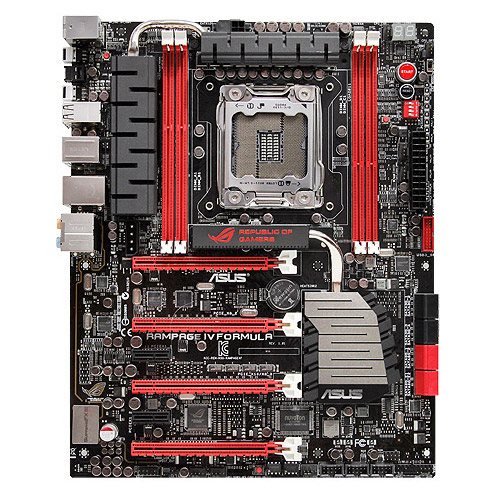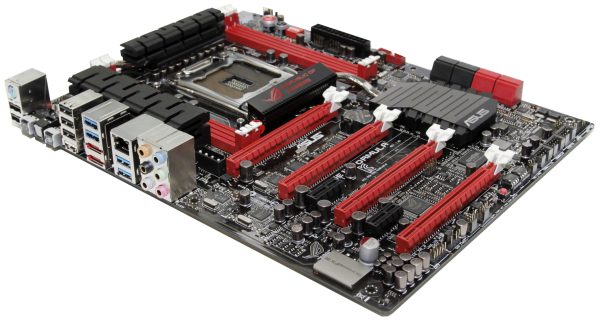ASUS Republic of Gamers and X79 ROG Review – Rampage IV Gene, Formula and Extreme
by Ian Cutress on August 3, 2012 1:00 PM EST- Posted in
- Motherboards
- Asus
- X79
- ROG
Rampage IV Formula Overview
In terms of product segmentation, the Formula hits that spot between ‘entry ROG’ and ‘extreme enthusiast’ by going after the ‘ROG Gamer’. As is apparent through looking at the range, the Rampage IV Formula is the product aimed at gamers. It still carries over a lot of features from both the overclocking oriented Extreme, and the gaming oriented Gene to create a board that fits a full fat ATX gamer wish. With the Formula, the main draw would be towards the multi-GPU compatibility. With four full-length PCIe slots drawing on the 40 PCIe lanes from the CPU, users can manipulate their cards whilst maintaining the maximum number of lanes in use.
A lot of what was said about the Gene carries over to the Formula, given that it is exactly the same design team and philosophy of attempting to push the boundaries – improved audio, robust heatsinks covering the power delivery, and the typical myriad of ROG features. With the Formula being a full sized board, we also now have space for all the intended SATA connectors to come on board, more fan headers, more USB headers, and even a switch to enable/disable PCIe slots to improve stability (potentially a beneficial sub-zero overclocker feature or for trouble shooting). We also have only four DIMM slots on the Formula, which is contrary to almost all other high-end full size ATX high-end X79 board on the market. The reasoning for this is that this is more of a gaming board, and typical memory usage for gamers is not going to be greater than 16GB (using a typical 4x4GB setup - the Formula does support 4x8GB). In addition, with more memory slots, this introduces extra routing and extra care in terms of tracing and testing – meaning that the Formula board is just a little easier to make while still keeping its marketed areas unaffected.
Performance of the Formula is similar to that of the Gene. The Formula also benefits from ASUS’ ‘MultiCore Enhancement’, making sure that the CPU uses the top turbo multiplier for full load and giving the board a 300 MHz boost (with an i7-3960X) against other X79 products. Comparing the Formula to the other ROG boards, we see that the Formula more often than not sits in the middle. Given the tracing layouts of the boards should be similar, I half expected each of the boards to be trading blows but surprisingly we see it often go in the pattern Extreme-Formula-Gene (or once or twice Gene-Formula-Extreme). Nevertheless, performance is certainly at the top of ASUS’ agenda with any ROG product.
Also similar to the Gene, the Formula comes with a competitive three-year warranty and is part of the ASUS Premium Service program for North America.
Visual Inspection

As always with ROG, red and black is the theme of the day. One can draw distinct parallels from the Formula with the Gene, especially as much of the layout near the socket is extremely similar. Those heatsinks covering the power delivery are seemingly almost identical, using bulky shapes and sizes with heatpipes to connect relevant areas. While this may seem like copy and paste on an industrial scale, I am not complaining. One thing that may raise an eyebrow is the decision to use four memory slots on an ATX board, instead of the standard eight. Arguments from ASUS to this aim at the market for this board, gamers, are most likely to not use more than 16 GB of memory (and the board does support 32GB if required) and implementation of the full set would drive the price outside the intended target.
Fan headers near the socket area are similar to the Gene – one 4-pin to the top left, two 4-pin headers to the top right and two 4-pin headers next to the 24-pin ATX power supply. Others are found on the bottom of the board, which gives us another three 4-pin fan headers.
Down the right hand side of the board showcases some more esoteric features that ROG is aimed at. Apart from the two-digit debug and the power/reset buttons that we see fairly often on high end boards, we also get switches to enable/disable PCIe slots (useful for stability), easy-to-solder voltage read points for overclockers, and an LN2 mode/slow mode set of switches and headers. LN2 mode, when enabled, gives users more BIOS options to play with, as well as extending BIOS ranges for voltages. Slow mode makes the processor run at a slow speed until disabled, at which point it will enable any overclocked settings (useful for sub-zero overclockers wanting to access the OS without losing extreme BIOS settings, or enabling the extreme OC in the OS).
Also down the right hand side are the chipset SATA ports (four SATA 3 Gbps in black, two SATA 6 Gbps in red) as well as another two SATA 6 Gbps (red) from an ASMedia controller. Above these is a USB 3.0 header (ASMedia).
The south side of the board is standard, with USB headers and fan headers. Different to the Gene is the two BIOS chips on the bottom of the board, and a BIOS switch that causes the board to jump between BIOSes before POST. This is also useful in case an enthusiast (read competitive overclocker) causes a BIOS to corrupt or not to reset properly. These BIOS chips are designed to be easy to remove, and are fully independent from each other.
For the PCIe, we have the following multi-GPU lane allocations:
One GPU: x16/-/-/-
Two GPU: x16/-/x16/-
Three GPU: x16/x8/x16/-
Four GPU: x16/x8/x8/x8
The sound subsystem, similar to the Gene, takes the 110dB SNR SupremeFX III and isolates the traces within an individual layer of the PCB, and partitions the sound on the edge of the board away from other components to improve quality. This is despite a 4-pin molex power connector being less than an inch away. This 4-pin power connector is to provide extra juice for multi-GPU setups under the most extreme conditions. Personally, I do not like it in this location, requiring cables to reach across the motherboard when in use, even when in a test bed - other motherboards have adapted connectors for additional SATA/PCIe power in easier to use locations.
Also onboard we find three optional temperature sensor headers, for enthusiasts to monitor their own locations within the build with their own thermocouples.
The rear IO panel is similar to that of the Gene – a PS/2 combination port, two USB 2.0, a USB BIOS Flashback button, SPDIF optical output, ROG connect button, a stack of four USB 2.0 ports (white being the USB Flashback and ROG Connect), four ASMedia USB 3.0 (blue), two eSATA (red), Intel gigabit Ethernet, and audio jacks.












34 Comments
View All Comments
jontech - Friday, August 3, 2012 - link
But sounds kind of cool,.Helps that Asus makes it :)
Paulman - Friday, August 3, 2012 - link
Asus Republic of Gamers also holds Starcraft tournaments, as well! That's how I first heard of their brand. In fact, the ASUS ROG Starcraft II Summer 2012 tournament is on right now and I'm watching a game vs. EG.IdrA and EG.Puma (same team, but one American teammate versus a Korean teammate).For more info on this tourney, see: http://rog.asus.com/142982012/gaming/join-the-rog-...
primeval - Friday, August 3, 2012 - link
A fun tournament thus far.For the branding portion of this article, I highly recommend checking out some of ASUS ROG's commercials. They have been playing throughout the aforementioned tournament and I have to say they are probably the best hardware commercials I have ever seen in terms of production quality. I think that if you see a few of those commercials, you may be able to further rationalize the branding award.
Meaker10 - Friday, August 3, 2012 - link
1x/16x/8x/16x would kill any dual card setup in a micro atx case, kinda defeating the point....just4U - Friday, August 3, 2012 - link
the 8x slot is rather pointless...danjw - Friday, August 3, 2012 - link
I would rather see an article on the Ivybridge ROG motherboards then the Sandybridge-E ones. These are very niche boards, though I guess that is only slightly less true of the Ivybridge boards. For heavily threaded and memory intensive applications Sandybridge-E will win. But not really on much else, though they are chosen by some just because they are the most expensive.StevoLincolnite - Friday, August 3, 2012 - link
Also, Sandy Bridge overclocks higher and throws out less heat, because of the silly design choice that Intel made in regards to the heat spreader compound.Not a problem for those who are up to the task of removing the IHS or lapping.
Sad part is that Ivy Bridge actually has nice thermals and power consumption at stock; which could have translated well for enthusiasts.
IvyBridge-E should be out within the next year, haswell will get released and the cycle shall continue.
Hopefully we get 8 core Ivybridge-E chips, which is severely lacking on the Socket 2011 platform with the 3930K's being die harvested 8 core chips, plus most socket 2011 motherboards will take an Ivybridge-e chip anyway, when they're released.
danjw - Friday, August 3, 2012 - link
I was just looking at "leaked" slide that shows Ivy Bridge-E out in Q3 2013 and Haswell out in Q2 2013. I really don't see what the point is of an Ivy Bridge-E if Haswell beats it to the market. With Sandy Bridge-E they released it before the Ivy Bridge tock. I just don't see why that would make much sense.Assimilator87 - Saturday, August 4, 2012 - link
Haswell will probably be limited to four cores, whereas Ivy Bridge-E will scale up to ten cores.mapesdhs - Wednesday, May 9, 2018 - link
I was hunting for R4E refs and found this. It's strange reading what people expected was going to happen back when the R4E was new. IB-E with 10 cores eh? Oh well. Mind you, that did happen with IB-EP, and infact the XEON E5-2680 v2 is one of the best upgrades one can do for an X79 mbd, at least for threaded performance anyway. Hard to avoid wondering how things would have panned out if the 3930K had simply been a fully functional 8-core in the first place, instead of the crippled sampled chip consumers were offered. However, I obtained quite a few, and they still work pretty well, especially with so many PCIe lanes to play with, and it's cool being able to use a 950 Pro to boot from NVMe (comes with its own boot ROM), though the ROG forum does have a thread with custom BIOS profiles available to add native NVMe boot support to various ASUS mbds.